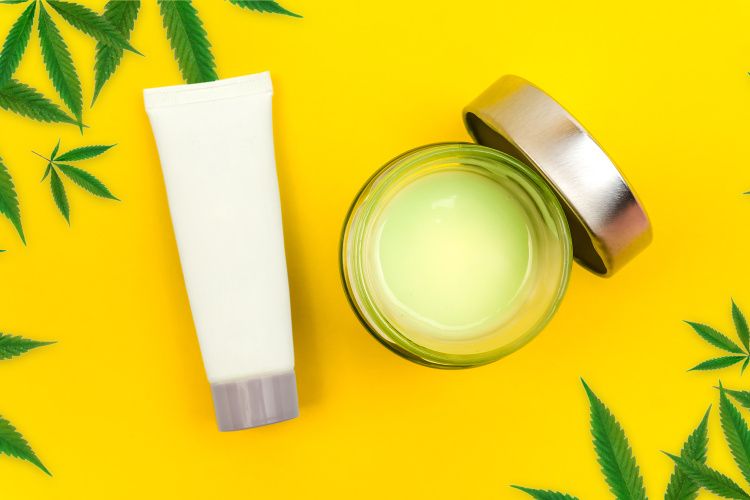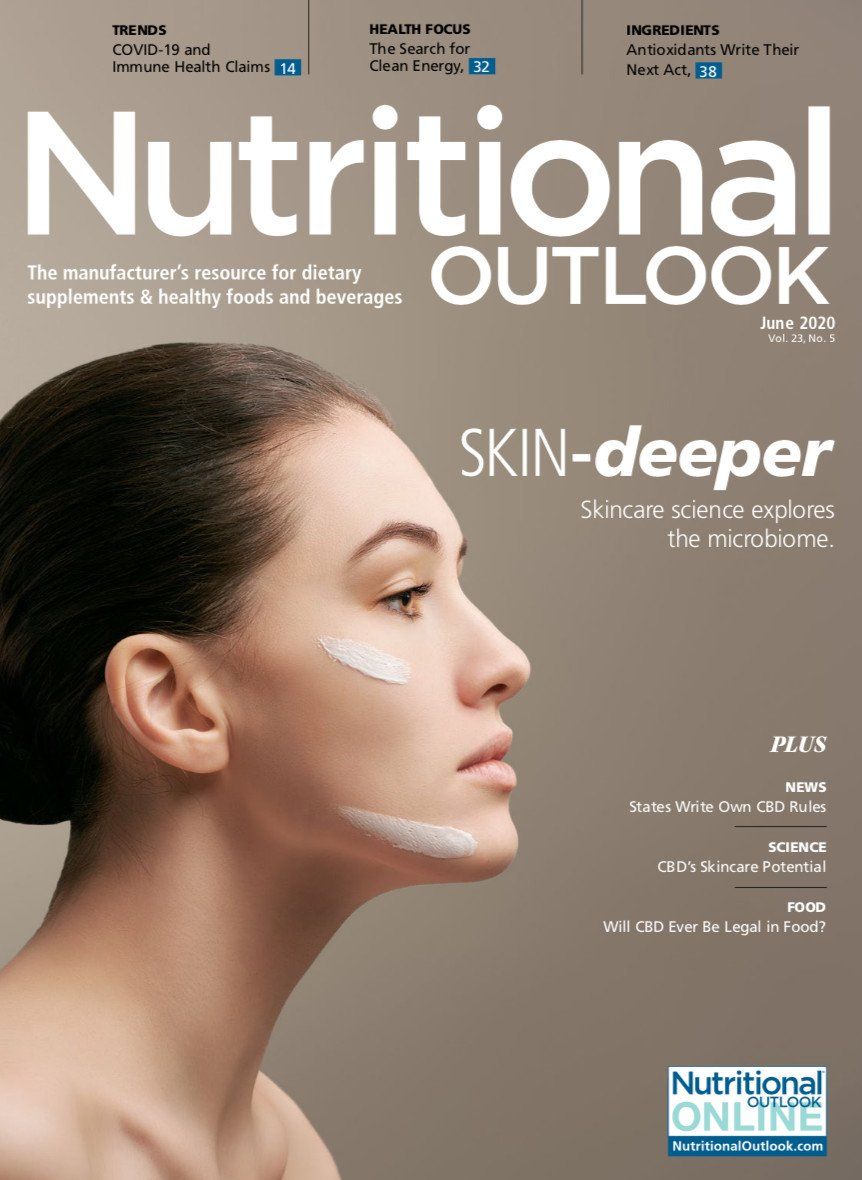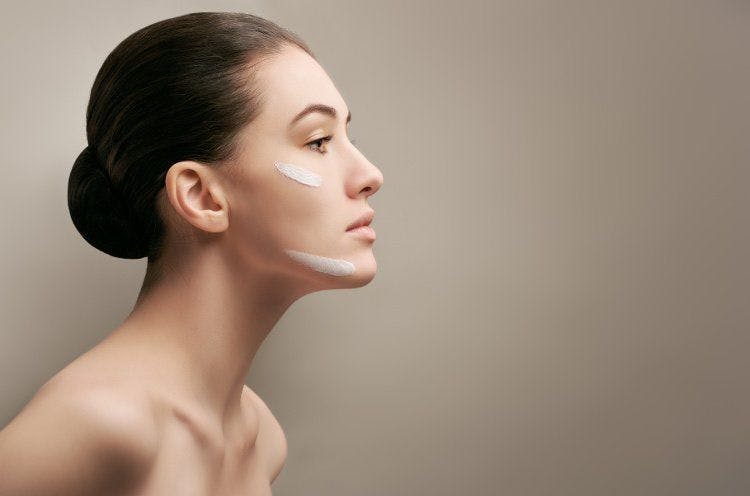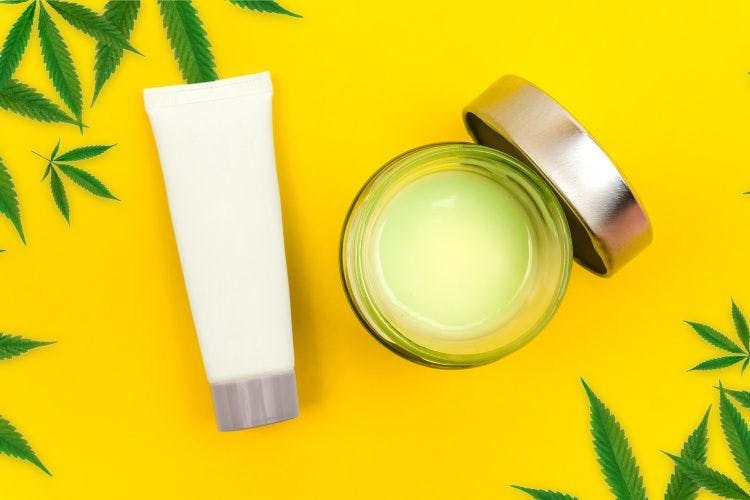Does CBD work on the skin?
What do we know, and how much do we still need to discover?
Photo © AdobeStock.com/MysteryShot

“Better than Botox.”
That’s what I overheard the lady at my gym say about her new cannabidiol (CBD) night cream. And from the looks of her, she appeared to be onto something.
Of course, my instincts as a health-and-wellness journalist automatically filtered her claim through a sieve of skepticism. But my 44-year-old forehead and I really wanted to believe.
So should we?
Not exactly, says Ari Sherman, president and cofounder, Evo Hemp (Boulder, CO). “I can understand where she was coming from,” he concedes, “but I don’t think anyone should expect similar results to Botox injections from CBD.”
They should expect something, though, right? After all, why else would everyone from beauty brand Kiehl’s to national pharmacy chain CVS be opening their doors to cannabis skincare products?
And why would Grand View Research predict a 32.9% CAGR through 2025 for the global CBD skincare market-bringing its value to $1.7 billion by the end of the forecast period1-unless consumers had reason to keep buying?
Sherman believes they do. “There are tremendous benefits to using CBD in skincare,” he says. It’s just that we’re only beginning to understand what, precisely, those benefits are, how CBD produces them, and how skincare products can deliver them to consumers-like me-who really want to believe.
What’s in a Name?
Writing in Here Comes Cannabis: How Legalization Will Disrupt Global Industries2, Zora Milenkovic, head of drinks and tobacco at Euromonitor International (Chicago), notes that “[h]empseed oil beauty and personal care products have been on the market for decades.”
But merely declaring “hemp” on a label no longer creates the buzz it once did. “The new superhero ingredient in beauty, CBD, has replaced hemp in references,” she says.
Of course, some may be wondering, “What’s the difference?” Given all the hemp, CBD, and other cannabis ingredients in personal-care products, you can’t blame them.
Simply put, all cannabis plants-including industrial hemp and marijuana-produce cannabinoids, naturally occurring compounds that defend the plants against environmental threats. Of the more than 100 cannabinoids that cannabis plants produce, CBD and tetrahydrocannabinol (THC) are the most well-known.
These cannabinoids trip endogenous cannabinoid receptors in their source plant to effect changes in the plant’s cells-which makes sense: that’s what they evolved to do. But what’s more surprising is that they do the same in us, acting on the human endocannabinoid system to produce therapeutic effects in CBD’s case-and psychoactive ones in THC’s-as well.
But while CBD-which can account for as much as 40% of a cannabis plant’s extract-is distributed throughout the stems, stalks, and flowers, you won’t find any in hemp oil. That’s because hemp oil-also billed as hempseed oil or Cannabis sativa seed oil-is pressed from hemp seeds, which contain no CBD at all.
Grow Operation
Notes Julie Winter, founding partner and COO of CBD For Life (Red Bank, NJ), “While hempseed oil doesn’t have the same benefits as CBD, it’s extremely high in antioxidants and omega-3 and -6 fatty acids.” In other words, it’s still good for you.
But as “one of the most abundant and heavily researched cannabinoids,” Winter continues, CBD remains the big draw.
Indeed, Jeanette Jacknin, MD, a holistic dermatologist speaking on behalf of Medterra (Irvine, CA), points to an increase of 370% in the number of online search trends for “CBD beauty” in the first two months of 2019 alone. Such interest, she believes, “is aided by the fact that today’s consumers want more natural products instead of laboratory-synthesized ones.”
Skin Deep
But along with an increase in online searches for CBD skincare, we’re likely to see an increase in misleading information about the science behind its efficacy, as well.
“The body of scientific literature on CBD is growing rapidly, with studies ranging from in vitro tests to trials in humans,” says a representative of Aceso Wellness, a subsidiary of Denver-based Dixie Brands. However, it’s still the case that “Right now, a simple Google search can produce a wealth of anecdotal stories about CBD’s benefits, but it can also provide a terrible amount of misinformation.” The task facing researchers and industry is thus to separate anecdote from actual benefit.
What we can say with confidence right now is that CBD, in concert with other active ingredients, “can work wonderfully on the skin,” CBD For Life’s Winter says. “CBD itself helps to calm and provide comfort. It’s a fantastic ingredient for anyone with sensitive skin, or anyone experiencing breakouts.”
Evo Hemp’s Sherman thinks that rather than likening CBD to Botox, a comparison with resveratrol-the polyphenolic antioxidant found in wine, berries, and other plant foods-is more apt. Resveratrol “has been clinically shown to help reduce signs of aging and repair and protect skin,” he says; CBD, similarly, “is also a really powerful antioxidant and anti-inflammatory.”
In fact, Sherman points to a growing number of government-approved clinical trials corroborating CBD’s antioxidant activity. He also notes that cannabis plants produce CBD and other cannabinoids as natural protectants against ultraviolet light-“so it’s the plant’s natural sunscreen, and it has these incredible properties that are great at not only protecting our skin but repairing it, too.”
Top-Level Benefits
It’s worth asking whether or not skincare’s topical application and transdermal absorption sufficiently convey CBD’s benefits to skin.
According to Medterra’s Jacknin, they do. “CBD is readily effective when applied topically, as the skin has a huge endocannabinoid signaling system with cannabinoid receptors in keratinocytes, sebaceous glands, hair follicles, nerves on the hair follicles, and dermal immune cells,” she explains. “They, in turn, work on the immune system via cytokines, mast cells, and other immune cells, as well as other types of receptors.”
The effect is rapid. “Ingested CBD takes as much as thirty minutes to several hours to produce the desired outcome, depending on the patient’s GI-tract transit time, absorption, and liver function-after which the CBD passes into the bloodstream to the organs,” Jacknin points out. By contrast, “Topical CBD products applied directly to the skin and problem areas can be designed to be absorbed rapidly, and they don’t have to go through the lungs or GI tract to eventually get a partial amount to the skin.”
And while Sherman notes that the skin’s barrier function is hard to breach, he concedes that dermal CBD application represents “a super-effective way of helping heal the top layer of skin. Just like a lot of other skincare products, it’s going to help improve the skin’s look, reduce the signs of aging, and more. “
Dose Response
Determining how much CBD to incorporate into a skincare product is another challenge in light of the vagaries of topical application and the influence of other actives in the formula.
Adds Jacknin, “Each individual responds differently to dosing with cannabinoids just as with other remedies and drugs. So some people with thin skin, a large peripheral blood supply, and certain genetics will respond to a much greater degree than others.”
Sherman admits that there “haven’t been a ton of trials on dosing, especially on topical products,” which can give dose determination a guesswork feel. But he says that skincare products will often declare the total amount of CBD per package-as, for example, the 175 mg of CBD in his company’s 1-oz roll-on, or the 750 mg in the line’s 4-oz tube of cream.
And to account for loss through skin, his company tends to settle on a 25- to 30-mg transdermal dose as roughly equivalent to a 15-mg oral dose.
Entourage Effect
Then again, a skincare product’s CBD dose may matter less than any adjunct ingredients the formulation contains to enhance absorption. As Aceso’s spokesperson reiterates, “In these applications, the CBD or hemp extract can be combined with emollients or other ingredients to enhance absorption by the skin.”
Even better, formulators can take advantage of naturally occurring compounds in the cannabis plant that potentiate CBD’s effects, as well.
That’s because although isolated CBD has advantages as an ingredient-an unobtrusive aroma; an easy-to-use powdered or crystalline format-it lacks many of the adjutants compounds, “like polyphenols and other antioxidants, ketones, and omega fatty acids,” Sherman says, “that are proven to be beneficial.”
By contrast, full- and broad-spectrum hemp extracts contain these compounds. “That’s why I always try to educate people on the broad benefits of hemp extract and not to get so tied up in the hype of CBD,” Sherman says. “CBD itself is great, but the true benefit that’s driving a lot of the health benefits we’re seeing is this group of other compounds in the hemp plant.”
Forward Focus
And researchers are learning more about them by the day.
Jacknin notes that Raphael Mechoulam, the Israeli organic chemist who in the 1960s first identified THC, recently announced the stabilization and synthesis of CBDa, a cannabinoid that he and his research team estimates is 1,000 times as potent as CBD. “I think there will be truly amazing strides in research in the new few decades,” Jacknin says. “We haven’t hit the tip of the iceberg in the science behind CBD and skincare.”
Sherman also anticipates research into novel cannabinoids. “CBD is awesome,” he says, “but there are all these other great cannabinoids that have tremendous benefits within the hemp plant, like CBG (cannabigerol), CBN (cannabinol), or CBC (cannabichromene).”
He even encourages more government involvement in the science. Why? “So that next time I have this conversation, there will be a tremendous amount more that we can base statistics and claims on,” he says. “I’m hoping that in the near future our government restrictions will open the floodgates to research, because that’s when things will get really interesting.”
Sidebar:
Hands-On: FDC, CBD, and why skincare is a “gateway application”
Attorney Justin J. Prochnow, shareholder, Greenberg Traurig LLP (Denver), considers topical CBD and hemp products “gateway applications for companies looking to dip at least their toes into the pool of hemp and CBD formulation.”
Why? “One of the main reasons is that FDA’s publicly stated position on CBD as not permissible in a dietary supplement, food, or beverage does not extend to non-ingestible products like topical skincare,” he says. Rather, as long as hemp and CBD ingredients meet the definition of industrial hemp-containing 0.3% THC or less-they’re fair game in topicals.
This loophole hasn’t escaped Ari Sherman, president and cofounder, Evo Hemp (Boulder, CO). “There’s no doubt in my mind that the recent explosion of CBD in skincare is completely because of FDA, from retailers down to brands,” he says. His company works with retailers like CVS and Whole Foods, whose legal teams draw the line at topical CBD products. “So if the lawyers tell the retailers,” Sherman says, “the retailers tell the brands. And the brands decide what to manufacture based on the channels they sell to.”
Granted, Prochnow notes, skincare products containing CBD and hemp must still be safe and bear permissible claims-which, at this point, are pretty limited. Because nondrug topical products may only claim to “cleanse,” “beautify,” “promote attractiveness,” or “otherwise alter the appearance of the skin,” claims that tout more enticing benefits will mark the products as drugs with FDA. As Prochnow says, “In the cosmetics world, beauty is skin deep-and so are claims. Any claims related to something deeper than the surface of the skin are likely to be viewed by FDA as drug claims.”
References:
- Grand View Research report. “CBD Skin Care Market Size, Share & Trends Analysis Report By Source (Hemp, Marijuana), By Type (Oils, Creams & Moisturizers, Masks & Serums, Cleansers), By Region, And Segment Forecasts, 2019 – 2025.” Published August 2019. Accessed at: www.grandviewresearch.com/industry-analysis/cbd-skin-care-market?utm_source=prnewswire.com&utm_medium=referral&utm_campaign=PRN_Aug29_cbdskincare_CMFE_RD1&utm_content=Content
- Euromonitor report. “Here Comes Cannabis: How Legalisation Will Disrupt Global Industries.” Published 2019. Accessed at: http://go.euromonitor.com/rs/805-KOK-719/images/wpCannabisDisruption-Final.pdf?mkt_tok=eyJpIjoiWmpabE1UaGlZekF4WVRNdyIsInQiOiJmYmxIVjAxcG9UZVZ2cjZONUUzUW1laURJckNLZlRlWlRtNURmdGhtRlJSeXlVbXBcL0F0WUU4YndQak1zM01CTFBQUHFCbW1iOE9Iak9OQ1lEc1lLZmpKYU9HRWZad2cza3BYOXk5M0Q0S0ZQb2h2THJFdHJVTmdVMXkrVWxuODEifQ%3D%3D

Prinova acquires Aplinova to further increase its footprint in Latin America
April 7th 2025Prinova has recently announced the acquisition of Brazilian ingredients distributor Aplinova, which is a provider of specialty ingredients for a range of market segments that include food, beverage, supplements, and personal care.



















